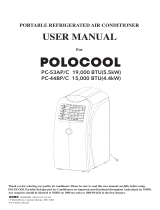17
EN
Important safeguards
• Use the appliance as described in this instruction manual only.
As with all electrical equipment, whilst the instructions aim to cover as many eventualities
as possible, caution and common sense should be used when operating and installing
the appliance.
• This appliance is designed for home air conditioning and must not be used for other pur-
poses.
• It is dangerous to modify or alter the characteristics of the appliance in any way.
• The appliance must be installed in conformity with national legislation regulating electri-
cal equipment and installations.
• If the appliance requires repair, contact the manufacturer's Customer Services only.
Repairs carried out by unauthorised personnel may be dangerous.
• This appliance must be used exclusively by adults.
• The appliance is not intended for use by persons (including children) with reduced physi-
cal, sensory or mental capabilities, or lack of experience and knowledge, unless they
have been given supervision or instruction concerning use of the appliance by a person
responsible for their safety.
Children must be supervised to ensure they do not play with the appliance.
• The appliance must be connected to an efficient earth system. Have your electricity
installation checked by a qualified electrician.
• Do not use extension cables.
• Before cleaning or maintenance, always unplug the appliance from the mains socket.
• Never unplug the appliance by pulling on the power cable.
• Do not install the appliance in rooms containing gas, oil or sulphur. Do not install near sour-
ces of heat.
• Keep the appliance at least 50 cm away from flammable substances (alcohol etc) or
pressurised containers (e.g. aerosol cans).
• Do not rest heavy or hot objects on top of the appliance.
• Clean the air filter at least once a week.
• Avoid using heating appliances near the air conditioner.
• The appliance must always remain upright or laid on one side during transportation. Befo-
re moving the appliance, empty the internal circuit completely of water. After moving the
appliance, wait at least 1 hour before starting it.
• When putting the appliance away, do not cover with plastic bags.
• The materials used for packaging can be recycled. You are therefore recommended to
dispose of them in special differentiated waste collection containers.
• At the end of its working life, consign the appliance to a specialist collection centre.
• If the power cable is damaged, it must be replaced by the manufacturer or the manu-
facturer's Customer Services in order to avoid all risk.
SPECIFIC WARNINGS FOR APPLIANCES WITH R410A* REFRIGERANT GAS
R410A refrigerant gas conforms to EC regulations on the environment. Avoid perforating the
refrigerant circuit of the appliance.
ENVIRONMENTAL INFORMATION: This unit contains fluorinated greenhouse gases covered by
the Kyoto Protocol. Maintenance and disposal must be carried out by qualified personnel
only (R410A, GWP=1975).
* Verify the type of refrigerant gas used in your appliance on the rating plate.













